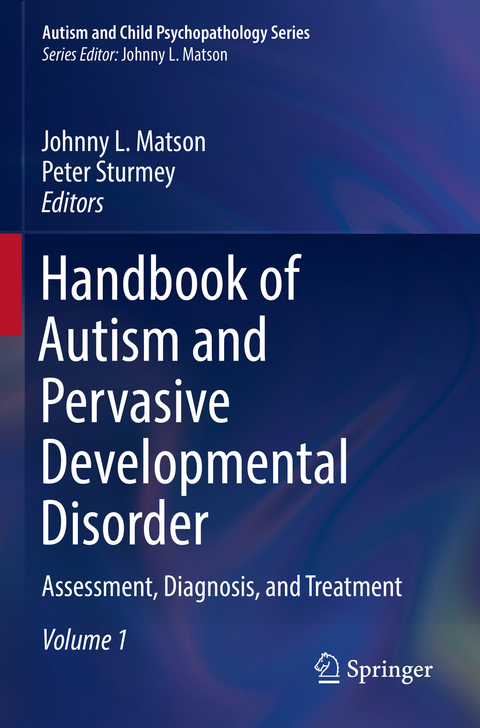
Handbook of Autism and Pervasive Developmental Disorder
Springer International Publishing
978-3-030-88540-3 (ISBN)
Key areas of coverage include:
- Survey of diagnostic criteria and assessment strategies for autism and pervasive developmental disorder.
- Genetic, behavioral, biopsychosocial, and cognitive models of autism assessment and treatment.
- Psychiatric disorders in individuals with ASD.
- Theory of mind and facial recognition in persons with autism.
- Diagnostic instruments for assessing core features and challenging behaviors in autism and PDD.
- Evidence-based psychosocial, pharmacological, and integrative treatments for autism and other developmental disabilities.
- Interventions specifically for adults with ASD.
- Training issues for professionals, parents, and other caregivers of individuals with autism and developmental disabilities.
- Review of findings of successful and promising therapies coupled with guidance on how to distinguish between dubious and effective treatments for autism and PDD.
The handbook is an indispensable resource for researchers, professors, graduate students as well as clinicians, therapists, and other practitioners in clinical child and school psychology, child and adolescent psychiatry, social work, special education, behavioral rehabilitation, pediatric medicine, developmental psychology, and all allied disciplines.
lt;b>Johnny L. Matson, Ph.D., is Professor and Distinguished Research Master in the Department of Psychology at Louisiana State University, Baton Rouge. He has served as major professor for 69 doctoral students over a 42-year career and has more than 850 publications, including 45 books. He is founding editor for the Review Journal of Autism and Developmental Disorders.
Peter Sturmey, Ph.D., is Professor of Psychology at The Graduate Center and Queens College, City University of New York. He has published more than 500 articles, chapters, and conference papers as well as 25 authored and edited books.
Section 1. And Introduction and Overview to Autism Spectrum Disorder and Pervasive Developmental Disorder.- Chapter 1. History of Autism Spectrum Disorder and Pervasive Developmental Disorder.- Chapter 2. Psychopathologies Associated with ASD and Pervasive Developmental Disorder.- Chapter 3. Challenging Behaviors Associated with Autism and Pervasive Developmental Disorder.- Chapter 4. Sensory Processing and Motor Issues in Individuals with ASD and Pervasive Developmental Disorder.- Chapter 5. Emotional Cognition, Theory of Mind, and Face Recognition in Individuals with Autism and PDD.- Chapter 6. Neurotechnology and Neuroimaging Devices for Assessing Autism and PDD.- Chapter 7. Risk Factors in Autism and Pervasive Developmental Disorder.- Chapter 8. Etiology of Autism and Pervasive Developmental Disorder.- Chapter 9. Epidemiology and Prevalence of Autism and Pervasive Developmental Disorder.- Chapter 10. Quality of Life for Individuals with Autism and Pervasive Developmental Disorder- Chapter 11. Family Adaptations for Individuals with Autism and Pervasive Developmental Disorder.- Chapter 12. Service Models for Autism and Pervasive Developmental Disorder.- Section 2. General Assessment Issues in Autism and Pervasive Developmental Disorder.- Chapter 13. Psychometric Principles and Standards for Assessing Autism and Pervasive Developmental Disorder.- Chapter 14. Diagnostic Systems for Autism and Pervasive Developmental Disorder.- Chapter 15. Purposes of Assessment in Autism and Pervasive Developmental Disorder.- Chapter 16. Effects of Cognition and Age on Assessment of Autism and Pervasive Developmental Disorder.- Chapter 17. Methods of Screening for Core Symptoms of Autism and Pervasive Developmental Disorder.- Chapter 18. Methods for Diagnosing ASD in Young Children.- Chapter 19. Methods for Diagnosing ASD in Adolescents and Adults.- Chapter 20. Monitoring Progress in Core Symptoms.- Section 3. Assessment Issues Related to Core Symptoms of Autism and Pervasive Developmental Disorder.- Chapter 21. Educational Assessment.- Chapter 22. Monitoring Educational Progress.- Chapter 23. Neuropsychology Assessment.- Chapter 24. Measuring Comorbid Psychopathology.- Chapter 25. Measuring Challenging Behaviors.- Chapter 26. Measuring Social Skills.- Chapter 27. Measuring Feeding Disorders.- Chapter 28. Measuring Psychotropic Drug Effects and Side Effects.- Chapter 29. Assessing Effects of Early Intervention.- Chapter 30. Assessing Transitions During School or Work Day and Across the Life Span.- Volume 2. Treatment of Autism and Pervasive Developmental Disorder.- Section 4. Ethics and Methods of Evidence-Based Practices in the Treatment of Autism and Pervasive Developmental Disorder.- Chapter 31. The Importance of Evidence-Based Practices and Autism.- Chapter 32. Methods for Evidence-Based Practices.- Chapter 33. An Overview of Effective, Evidence-Based Autism Treatments.- Chapter 34. Disseminating Evidence-Based Practice Guidelines for Autism.- Section 5. Early Intervention in the Treatment of Autism and Pervasive Developmental Disorder.- Chapter 35. Early Intensive Behavioral Intervention for Autism and PDD.- Chapter 36. Economics of Early Intensive Behavioral Intervention for Autism and PDD.- Chapter 37. Developmental and Hybrid Treatment Approaches for Autism and PDD.- Chapter 38. The Denver Model.- Chapter 39. Prevention and Early Intervention for At-Risk Children.- Chapter 40. Early Development of Problem Behavior and Implications for Prevention.- Section 6: Applied Behavior Analysis.- Chapter 41. History of Applied Behavior Analysis.- Chapter 42. Foundational Principles of ABA.- Chapter 43. Skills Training and ABA.- Chapter 44. GeneralizedLimitations and ABA.- Chapter 45. Self-Help Skills and ABA.- Chapter 46. Social Behavior and ABA.- Chapter 47. Verbal Behavior and ABA.- Chapter 48. Alternate and Augmentative Communication and ABA.- Chapter 49. Equivalence-Based ABA Interventions.- Chapter 50. Academic Skills and ABA.- Chapter 51. Vocational Skills and ABA.- Chapter 52. Technology and ABA.- Chapter 53. Self-Management Skills and ABA.- Chapter 54. Problem Behavior and ABA.- Chapter 55. ABA Treatment Approaches to Problem Behavior.- Chapter 56. Food -Related Disorders and ABA.- Chapter 57. ABA Training for Parents and Caregivers.- Chapter 58. Organizational Behavior Management and Autism.- Chapter 59. Restrictive Behavior Management Practices.- Chapter 60. Development of New Profession.- Section 7. Psychopharmacology.- Chapter 61. Psychotropic medications: Definitions and Methods of Action.- Chapter 62. Epidemiology ofPsychotropic Medications.- Chapter 63. Evaluating the Effectiveness of Psychotropic Medications: Principles, Experimental Design and Outcomes Measures.- Chapter 64. Rational Prescription of Psychotropic Medications.- Chapter 65. Anxiolytic and Antidepressant medications.- Chapter 66. Antipsychotic Medications.- Chapter 67. Psychotropic Medications for Sleep Disorders.- Chapter 68. New Psychotropic Agents.- Chapter 69. Interactions Between Psychotropic Medications and Other Treatments.- Chapter 70. Caregiver Education and Treatment Adherence.- Chapter 71. Medication Reduction Programs.- Section 8. Psychosocial Treatments.- Chapter 72. Mindfulness.- Chapter 73. Cognitive Behavior Therapy.- Chapter 74. Third Wave Behavior Therapies.- Chapter 75. Sensory Interventions.- Chapter 76. Special Education.- Chapter 77. Positive Behavior Support.- Chapter 78. Interventions for Family Members.- Chapter79. Animal Assisted Therapy.- Chapter 80. Robot Assisted Therapy.- Chapter 81. Music Therapy.- Section 9. Other Biological Treatments.- Chapter 82. Diets.- Chapter 83. Chelation, Hyperbaric Oxygen and Other Fringe Biomedical Treatments.- Chapter 84. Complementary and Alternative Therapies.- Section 10. Special Populations and Problems.- Chapter 85. Adults with Autism Spectrum Disorder.- Chapter 86. Individuals with Asperger Syndrome.- Chapter 87. Girls and Women with Autism Spectrum Disorder.- Chapter 88. Gay, Lesbian and Gender Nonconforming Individuals with Autism.- Chapter 89. Offenders with ASD.- Chapter 90. Promoting Good Health in Individuals with Autism Spectrum Disorder.- Chapter 91. Neurodiversity, Self-Advocacy and Anti-Therapy.
| Erscheint lt. Verlag | 15.10.2023 |
|---|---|
| Reihe/Serie | Autism and Child Psychopathology Series |
| Zusatzinfo | XII, 1609 p. 29 illus., 8 illus. in color. In 2 volumes, not available separately. |
| Verlagsort | Cham |
| Sprache | englisch |
| Maße | 155 x 235 mm |
| Gewicht | 2726 g |
| Themenwelt | Geisteswissenschaften ► Psychologie ► Entwicklungspsychologie |
| Geisteswissenschaften ► Psychologie ► Pädagogische Psychologie | |
| Medizin / Pharmazie ► Medizinische Fachgebiete ► Psychiatrie / Psychotherapie | |
| Technik ► Umwelttechnik / Biotechnologie | |
| Schlagworte | Academic skills, special education, and ABA • Alternative and augmentative communications • Applied Behavior Analysis (ABA) and autism • Autism spectrum disorder and psychopathology • CBT, mindfulness and developmental disabilities • Challenging behaviors and autism • Early Intensive Behavioral Intervention and autism • Early Start Denver Model (ESDM) and autism • Education and developmental disabilities • Emotional cognition, face recognition and autism • Family adaptations and autism • Feeding disorders and autism • Neuropsychology assessment and autism • Neurotechnology, neuroimaging and autism • Parent and caregiver training and autism • Positive behavior support and autism • Psychotropic drugs, ASD, PDD • Sensory processing, motor issues and autism • Sleep disorders and developmental disorders • Social skills and PDD |
| ISBN-10 | 3-030-88540-2 / 3030885402 |
| ISBN-13 | 978-3-030-88540-3 / 9783030885403 |
| Zustand | Neuware |
| Haben Sie eine Frage zum Produkt? |
aus dem Bereich


